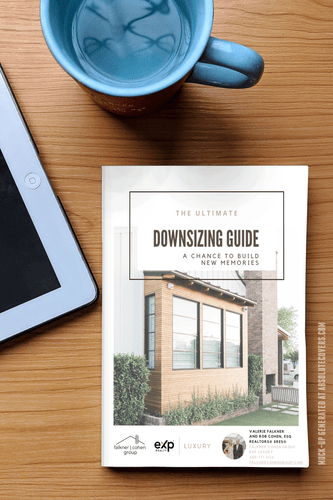Downsizing a home is a significant decision that involves various practical and emotional factors.
To receive our full 20 page Downsizing Guide, click now.
Here are some key considerations:
1. Lifestyle and Needs
- Space Requirements: Reflect on your current lifestyle and how much space you truly need. Do you often host guests, or do you need room for hobbies or a home office? Downsizing may mean sacrificing certain spaces, so it's essential to identify what's necessary for your day-to-day life.
- Future Needs: Consider any anticipated changes, such as aging in place or potential mobility challenges. A smaller home might be more manageable long-term, but think about accessibility features (e.g., fewer stairs, wider doorways).
2. Financial Factors
- Selling Your Current Home: The proceeds from selling your current home will significantly impact your next steps. Consider the market value of your home, how long it may take to sell, and how much equity you have built.
- Mortgage and Expenses: A smaller home may mean a smaller mortgage or none at all, depending on your situation. However, it’s also essential to factor in ongoing costs, such as property taxes, insurance, utilities, and maintenance. Will your new home save money or potentially create new financial challenges?
- Cost of Moving: Don’t forget moving costs. These can include hiring movers, packing, and the cost of repairs or renovations in the new home to make it move-in ready.
3. Emotional Considerations
- Sentimental Attachment: Homes often carry memories, and it can be tough to part with them. It’s important to assess how emotionally attached you are to your current space and whether you’re ready for a change.
- Downsizing Stress: The process of sorting through belongings and letting go of items can be overwhelming. The emotional strain of giving up family heirlooms or possessions accumulated over the years is a real factor to consider.
4. Location
- Proximity to Family and Friends: Consider whether the new location will keep you close to loved ones. Moving farther away can impact your social life and support system, especially in retirement.
- Access to Services and Amenities: Evaluate the convenience of nearby services such as grocery stores, hospitals, public transportation, and other essential services. A location that's closer to things you need can improve your quality of life in a smaller space.
5. Maintenance and Upkeep
- Lawn Care and Exterior Maintenance: A smaller home often means less yard work, but it's essential to think about how much upkeep the exterior and interior will require. A condo or townhome might have shared maintenance responsibilities, while a standalone house could still demand regular attention.
- Repairs and Renovations: A home with fewer rooms may need less upkeep, but consider whether you'll have to invest in repairs or upgrades to make it comfortable and suitable for your needs.
6. Storage and Decluttering
- Decluttering: Downsizing requires you to declutter significantly. Take stock of what you truly need versus items you’ve accumulated over time. Downsizing often forces you to streamline your possessions, which can be an overwhelming but ultimately freeing process.
- Storage Solutions: Think about how you’ll manage storage in a smaller space. Will you need to rent a storage unit, or can you make use of clever storage solutions in the new home?
7. Resale Value
- Future Value of the New Home: Even though you’re downsizing, consider the long-term investment potential of your new home. Will it appreciate in value? Is it located in a desirable neighborhood? Understanding the resale prospects can help you make a more informed decision for the future.
8. Health and Accessibility
- Aging in Place: If you anticipate aging in the home, consider how easy it will be to navigate as you age. Features like single-story layouts, wheelchair accessibility, or wider hallways and doors are worth looking into.
- Health Considerations: If your health or mobility is a concern, downsizing into a space that’s easier to maintain physically (e.g., fewer stairs or larger bathrooms) could help you stay independent longer.
9. Community and Social Opportunities
- Neighborhood Dynamics: Will your new community offer social opportunities that fit your lifestyle? Whether it's a quiet suburban neighborhood or a more active, age-restricted community, the social atmosphere can have a big impact on your overall satisfaction.
- Social Support Networks: Consider the presence of social and community support networks. If you’re downsizing in retirement, look into local groups, clubs, or organizations that might help you stay engaged.
10. Renting vs. Buying
- Renting a Smaller Home: For some, renting might be a more flexible and less stressful option than purchasing a new home, especially if there’s uncertainty about future plans or locations.
- Buying: If you’re committed to purchasing, consider whether now is the right time for a home purchase, especially if housing markets are volatile or interest rates are high.
By considering these factors thoughtfully, you can ensure that your downsizing decision supports both your immediate and long-term goals.
To receive our full 20 page Downsizing Guide, click now.










